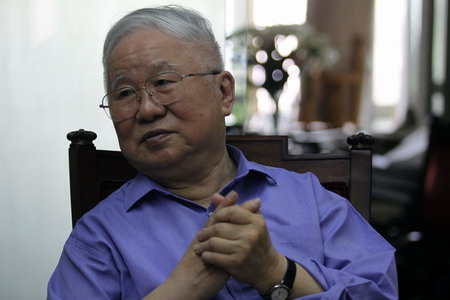By Wang Ru (China Daily)

China's famous architect and city designer, Wu Liangyong,
during an exclusive interview with China Daily in Beijing.
He prefers to be thought of as an architecture educationist. [China Daily]
BEIJING - Witnessing the 1940 Japanese bombings that ruined almost half of the town near Chongqing where he lived, 18-year-old Wu Liangyong was determined to rebuild the wreckage.
Seventy years after those bombings, as a world-renowned architect and city designer, 88-year-old Professor Wu received the 2010 Tan Kah Kee Science Award in Beijing for his creative research on the science of human settlements, and for his significant contributions to the study of urban and regional development in China.
Having just recovered from a stroke, Wu, also a member of the Chinese Academy of Science and the Chinese Academy of Engineering and a professor with the school of architecture of Tsinghua University, resumed to supervise his doctoral students at his home in Beijing. No matter how many honors he receives, Wu always prefers to be thought of as an architecture educationalist.
Wu was born in 1922 in Nanjing. In 1946, after receiving his bachelor's degree in architecture in Chongqing, Wu assisted Liang Sicheng, who is recognized as the father of modern Chinese architecture, in founding the school of architecture of Tsinghua University.
In 1948, Wu went to study at the Cranbrook Academy of Art in the United States, where he became one of the last batch of students of Eliel Saarinen, the world-famous architect master. Wu received his master's degree in architecture in 1950.
Knowing that New China needed many architecture specialists to rebuild the country after the ruins of war, Wu returned to Tsinghua University and began teaching.
During the past decades, Wu has devoted himself to architectural education. He advocated bringing modern architecture knowledge into education and utilizing that knowledge in local practices in China.
In 1978, the opening up and reforms brought a great turning point for both the country and Wu. The successful economic revival made Wu realize that the country would embrace accelerated urbanization and would have to face the problems it caused.
Wu has led many important projects all over China, including the study of the Olympic construction in Beijing, design of the new Beijing Library and the expansion of the Tian'anmen Square, and the Confucius Research Institute in Shandong.
As an urban and regional planner, he raised the proposal of "planning the Greater Beijing and building a World City" and joined in the research of the urban and rural developments of Beijing, Tianjin and Hebei.
In 1989, Wu published his book, The Architecture Concept on Broad Sense, which defines architecture from a broad perspective including human settlements, economy, technology, culture, policy-making and philosophy.
From 1987 to 1992, Wu planned, designed and supervised the renovation project of Ju'er Hutong in Beijing. It was a successful experimental project that combines new houses with the rehabilitation of courtyard houses.
Wu believes that a city is an organic system, which has its own metabolism. Old buildings that are still in sound condition, with historic values, should be retained. Those in average condition should either be renovated or added onto as necessary, and those that are badly dilapidated need to be replaced by new ones.
On World Habitat Day (Oct 4) in 1993, Wu received the World Habitat Award for 1992 at the United Nations headquarters.
The jury's evaluation remark was: "The Ju'er Hutong Courtyard Housing Project is pioneering a new approach to urban renewal in the heart of Beijing. Traditional courtyards are being restored and improved, avoiding the need for wholesale demolition of historic but dilapidated inner-city housing. Equally important, the project seeks to bring about a new approach to the funding and planning of housing provisions within historic cities."
Wu creatively put forward the concept of sciences of human settlements, which is an applied knowledge concerning the national economy and people's livelihood.
In 1999, the 20th World Congress of Architects in Beijing passed the Beijing Chapter drafted by Wu, which summarized the world architecture development in the past century and unfolded an outlook for the future of architecture in the 21st century.
Wu has a solid belief on building sustainable human settlements in the urbanizing world and adequate shelter for all.
"The value of land is accumulated by generations. Nobody has the right to misuse or over-exploit the value of our land," Wu said, commenting on the skyrocketing land prices.
He is a staunch supporter of the government's movement to build welfare and low-rent housing for low-income families.
He criticized some cities in China for becoming the "trial field" for foreign architects, who produced many odd buildings that are in disharmony with the original landscape and culture in those cities.
"We should learn from the developed countries, but not merely copy them. Chinese architects need to understand our culture first," he said.
In his spare time, Wu likes painting and calligraphy. He is also a famous artist of traditional Chinese paintings and has held seven exhibitions.
"My dream about the future is that we could live in nice houses in harmony with nature. We could live like in the poems and paintings," he said.
